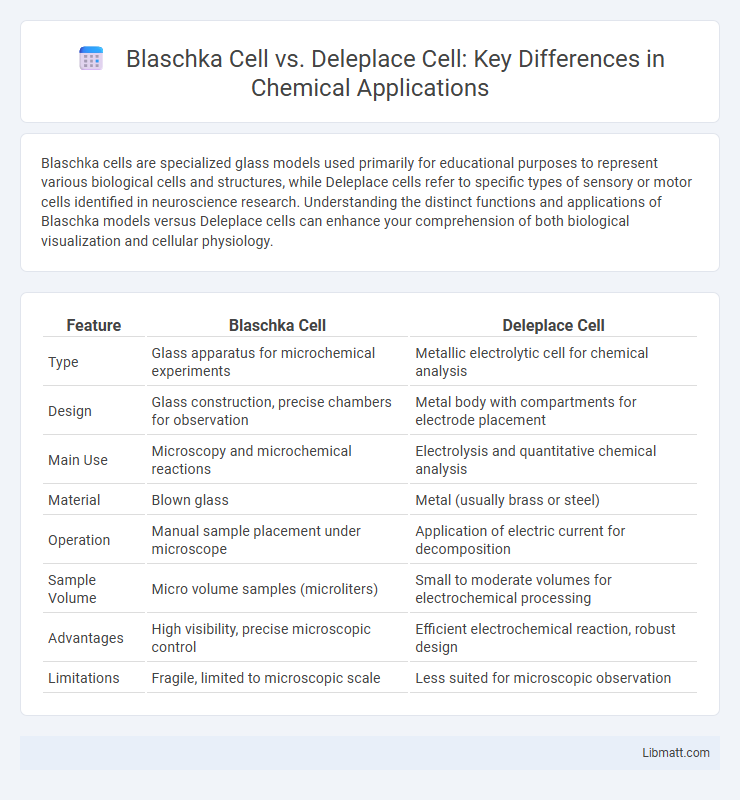Blaschka cells are specialized glass models used primarily for educational purposes to represent various biological cells and structures, while Deleplace cells refer to specific types of sensory or motor cells identified in neuroscience research. Understanding the distinct functions and applications of Blaschka models versus Deleplace cells can enhance your comprehension of both biological visualization and cellular physiology.
Table of Comparison
| Feature | Blaschka Cell | Deleplace Cell |
|---|---|---|
| Type | Glass apparatus for microchemical experiments | Metallic electrolytic cell for chemical analysis |
| Design | Glass construction, precise chambers for observation | Metal body with compartments for electrode placement |
| Main Use | Microscopy and microchemical reactions | Electrolysis and quantitative chemical analysis |
| Material | Blown glass | Metal (usually brass or steel) |
| Operation | Manual sample placement under microscope | Application of electric current for decomposition |
| Sample Volume | Micro volume samples (microliters) | Small to moderate volumes for electrochemical processing |
| Advantages | High visibility, precise microscopic control | Efficient electrochemical reaction, robust design |
| Limitations | Fragile, limited to microscopic scale | Less suited for microscopic observation |
Introduction to Blaschka Cell and Deleplace Cell
Blaschka cells, named after German glass artists Leopold and Rudolf Blaschka, are intricate glass models used for educational purposes to represent cellular structures with high accuracy. Deleplace cells refer to plant cells characterized by their large vacuoles and rigid cell walls, critical for maintaining turgor pressure and structural integrity in vegetation. Both Blaschka and Deleplace cells contribute to biological education through detailed visual representation and highlighting distinctive cellular features in animal and plant biology respectively.
Historical Background and Development
Blaschka cells were first described in the late 19th century by Leopold and Rudolf Blaschka, pioneering intricate glass models to represent marine invertebrate cells and tissues for educational purposes. Deleplace cells, identified in the early 20th century by French neuroscientist Deleplace, contributed foundational knowledge to neurophysiology through detailed histological studies of nerve cells. Your understanding of cellular anatomy benefits from recognizing the historical development of these models, as they both advanced the visualization and comprehension of complex cellular structures.
Structural Differences
Blaschka cells exhibit a simpler morphology with fewer dendritic branches and lack the extensive axonal projections characteristic of Deleplace cells. Deleplace cells possess a more complex structure, featuring well-defined dendritic trees and multiple axonal terminals that facilitate extensive synaptic connectivity. These structural differences highlight the functional specialization of Deleplace cells in neural circuitry compared to the more basic integrative role of Blaschka cells.
Functional Roles in Biological Systems
Blaschka cells are specialized sensory receptors involved primarily in environmental signal detection, playing a critical role in invertebrate sensory systems. Deleplace cells function mainly in spatial orientation and navigation within the nervous systems of vertebrates, particularly in encoding positional information. Understanding your biological research requires recognizing that Blaschka cells contribute to external stimulus processing, while Deleplace cells are integral to internal spatial mapping.
Key Applications in Modern Science
Blaschka cells are pivotal in developmental biology for modeling embryonic cell differentiation, offering insights into tissue formation and regenerative medicine. Deleplace cells facilitate advanced research in neurobiology, particularly in studying neural connectivity and synaptic plasticity. Your research can benefit from integrating findings derived from both Blaschka and Deleplace cells to enhance understanding of cellular functions in health and disease.
Advantages of Blaschka Cell
Blaschka cells offer superior structural detail and durability compared to Deleplace cells, making them highly reliable for long-term microscopic studies. Their intricate glass craftsmanship allows for precise replication of cellular morphology, enhancing educational and research visualizations. This precision aids in better understanding of cellular interactions and physiological processes.
Benefits of Deleplace Cell
Deleplace cells offer enhanced regenerative capabilities and improved integration into existing neural networks compared to Blaschka cells, making them highly effective for neurobiological research and therapeutic applications. Their robust resistance to environmental stress and higher differentiation potential provide superior results in cell replacement therapies. Your research or treatment plans can greatly benefit from utilizing Deleplace cells for more reliable and sustained cellular performance.
Comparative Analysis: Blaschka vs Deleplace Cell
Blaschka cells and Deleplace cells differ primarily in their structural complexity and functional roles within sensory systems, with Blaschka cells typically associated with mechanoreception and possessing intricate dendritic arbors for signal integration. Deleplace cells exhibit more uniform morphology, often linked to proprioceptive feedback and motor coordination. Comparative studies highlight Blaschka cells' enhanced synaptic plasticity compared to Deleplace cells, suggesting distinct contributions to neural circuitry and sensory processing.
Research Advances and Innovations
Research advances have highlighted the distinct roles of Blaschka cells and Deleplace cells in neurophysiology, with Blaschka cells showing enhanced synaptic plasticity critical for memory formation, while Deleplace cells are identified as key players in spatial navigation and environmental mapping. Innovations in imaging techniques, such as two-photon microscopy, have enabled detailed observation of Blaschka cell signaling pathways, revealing new molecular targets for neurodegenerative disease therapies. Your understanding of these cell types can benefit from integration of recent genomic analyses that decode their unique receptor profiles and functional gene expressions.
Future Perspectives and Potential Impacts
Blaschka cells, with their intricate biocompatible designs, offer promising advancements in tissue engineering and regenerative medicine, potentially revolutionizing personalized healthcare by enabling more accurate cellular modeling. Deleplace cells, known for their robust neural differentiation capabilities, hold significant potential for developing innovative treatments for neurodegenerative diseases and improving brain-computer interface technologies. Your research integrating both cell types could accelerate breakthroughs in cellular therapies and biomedical applications, shaping the future of precision medicine.
Blaschka cell vs Deleplace cell Infographic

 libmatt.com
libmatt.com